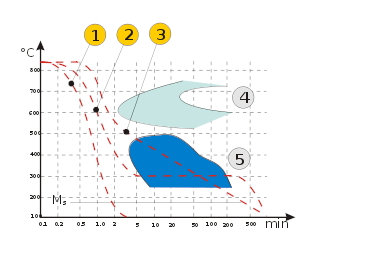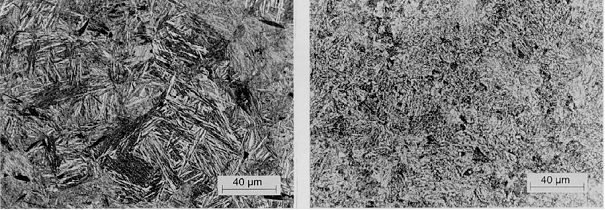Bainite
Structure that may develop during heat treatment of carbon steel by isothermal transformation or continuous cooling from austenite at temperatures below those of pearlite and martensite formation (named after Edgar C. Bain, USA).
Bainite has an acicular structure similar to martensite and comprises a mixture of ferrite and carbides. The prerequisite for bainite formation is compliance with a specific cooling sequence, and it must be ensured that neither martensite nor pearlite is formed.
In everyday language it is often referred to as bainitic cast iron, which is not correct in most cases since carbides are unwanted. Consequently, bainitic cast iron is a mixture of fine-grain acicular ferrite and highly carbonaceous austenite (stabilized by carbon). Compared to that, bainite in steel comprises ferrite and carbides.
The TTT diagram (Fig. 1) illustrates the correlations by the example of three different cooling curves, starting at austenitization temperature. Curve 1 shows quenching to martensite. In contrast to that, curve 2 illustrates typical austempering; here, cooling is stopped at a temperature value in the range of bainitic transformation, it is isothermally kept at this level and after a specific period cooled further to room temperature. Curve 3 shows cooling to bainite; it continues past the pearlite peak and through the region of bainitic transformation at continuous cooling speed, as is the case in a sand mold, for example. Curves 4 and 5 are schematic diagrams of the pearlite and bainite regions, respectively.
The mechanical properties of bainite, particularly its toughness properties may differ and depend on the temperature range within which bainite was formed. The structure referred to as “upper bainite” (Fig. 2, LH image) occurs at transformation temperatures directly below the region for pearlite formation. Due to the favorable diffusion conditions present here, carbon diffuses to the grain boundaries of the ferrite acicules and generation of irregular interrupted carbides (cementite) may be promoted. Due to random distribution, the structure often has a granular appearance (granular bainite). In contrast to that, the structure referred to as “lower bainite” (Fig. 2, RH image) occurs at transformation temperatures directly above the region for martensite formation. Here, austenite accumulates around the carbon molecules due to ferrite formation; after further cooling, these austenite regions transform to ferrite, cementite, acicular bainite, and possibly martensite.
Upper bainite achieves higher impact working values than lower bainite and the range of its transformation temperature is significantly higher. As a general rule, lower bainite has lower upper shelves and lower transformation temperatures, which are favorable characteristics for application at low temperatures.
Additional references:
Metal matrix of cast iron
Structure formation of cast iron
Cast iron
Austenitic cast iron, Carbidic cast iron, Ferritic cast iron



